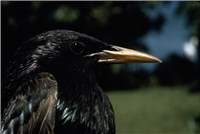Family
Sturnidae
Genus
Sturnus
Species
vulgaris
Threats/Control Methods - Regional
The increasing number of Common Mynas (Acridotheres tristis ) in Canberra can be directly linked to the decreasing number of Common Starlings, as they are direct competitors.
Threats/Control Methods - Local
The Common Starling is known to drive native birds out of nesting hollows and it considered a threat to many other bird species.
Local/Urban Actions
To increase the survival chances of all local birds, cat owners can prevent their pets from hunting by creating a stimulating indoor environment and by installing a cat run or enclosure. Starlings should be removed from any tree hollows or nest boxes if they are seen, so that native species might use them instead. Food scraps should not be left out in places where Starlings can eat them.
Common Names
Common Starling, European Starling, Starling, English Starling
Distinguishing Features
The plumage of the Common Starling changes throughout the year. In autumn, plumage is new and glossy black with a green-purple shine and white spots on wing tips. Over the year the gloss fades. When breeding, adults loose their white spots and males more glossy than females.
Survey Techniques
Call and visual identification.
Species Call
Wheezy whistles, clicks and scratching notes and some mimicry of other birds.
Similar Species
The Starling is similar in size and shape to the Common Blackbird (Turdus merula ), however the Blackbird's plumage is plain.
Distribution
This species is common across the east and south east of Australia.
Country of Origin
Europe. It was first introduced to Australia in the 1850s.
Conservation (Pet/Pest) Status - Regional
This species is declining gradually in the ACT (COG).
Conservation (Pet/Pest) Status - National
Introduced, common and abundant.
LSCCES Population
The Common Starling was found in highest numbers in Civic West, with moderate numbers found in all other areas, excluding the ANBG and BMt.
Associated vegetation community
Originally from European woodland environments; Common Starlings now thrive in suburban areas, preferring irrigated ovals and playing fields for foraging.
Limiting Resources
Nesting hollows or similar man-made shelters are needed for breeding. Numbers are declining in the ACT due to the decreasing number of irrigated playing fields available as their preferred feeding habitat.
Breeding
In the Canberra region, nest building begins in August and peaks in September. The nest is an untidy cup of grasses, leaves, twigs and items of human rubbish. Nest sites are any type of hollow, such as tree hollows and house roof voids. 4-8 pale blue eggs are incubated by both sexes for 12 days. Often two broods are raised in a season and dependant young can be seen as late as March.
Behaviour
The birds are often seen foraging on grassed areas in large flocks. In the evenings they can also be seen in large flocks, searching for a roosting site. When breeding, the Common Starling can become aggressive and drive native birds out from nesting sites.
Functional Group
Food Species
Common Starlings mostly feed on seeds and insects from irrigated grassed areas. Other food includes spiders, worms, human scraps and fruit crops.
Predators
The Pied Currawong (Strepera graculina ) is known to feed on the eggs and young of this species. It is also prone to attacks from domestic pets or from birds of prey like the Collared Sparrowhawk (Accipiter cirrhocephalus ).
Interesting Fact
The dull brown bill of the Common Starling turns bright yellow during the spring-summer breeding season.
References - (reader suitability of references, P=Primary teachers, S=Secondary students, T=Tertiary students and researchers)
Books:Morcombe, M. 2000. Field Guide to Australian Birds. Steve Parish Publishing. Archerfield. Australia P, S, T
Schodde, R. and Tideman, S. (eds) 1990. Reader's Digest Complete Book of Australian Birds (2nd Edition). Reader's Digest Services Pty Ltd. Sydney. P, S, T
Veerman, P. 2003. Canberra Birds: A report on the first 21 years of the garden bird survey. Philip Veerman and Canberra Ornithologists Group. Canberra. S, T
Internet: Birds in Backyards. 2006. [online]. Available at:http://www.birdsinbackyards.net P, S, T
Birds in Backyards. 2006. Birds Behaving Badly - Pied Currawong. Australian Museum. [online]. Available at:http://birdsinbackyards.net/feature/birds-behaving-badly-currawong.cfm P, S, T
Canberra Ornithological Group (COG). 2004. Birds of Canberra Gardens. COG and the ACT Department of Urban Services. [online]. Available at:http://garden.canberrabirds.org.au/ P, S, T
Online Publications:Nix, H. and Cunningham, R. 2006. Birds of the Lower Sullivans Creek Catchment, Canberra ACT. Prepared for the Life in the Suburbs project using data from the Lower Sullivans Creek Catchment Ecological Survey (LSCCES). Australian National University. Canberra. [online]. Available at http://www.lifeinthesuburbs.com.au/category.php?id=65 S, T

 Top
Top Top
Top